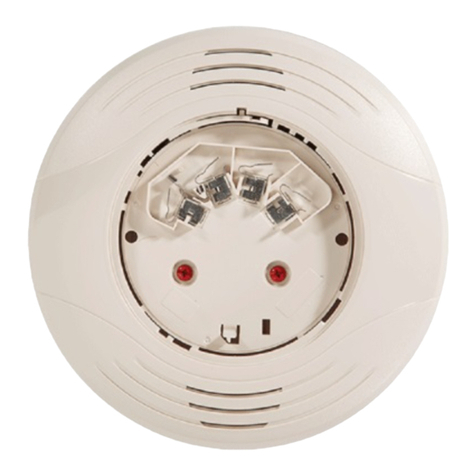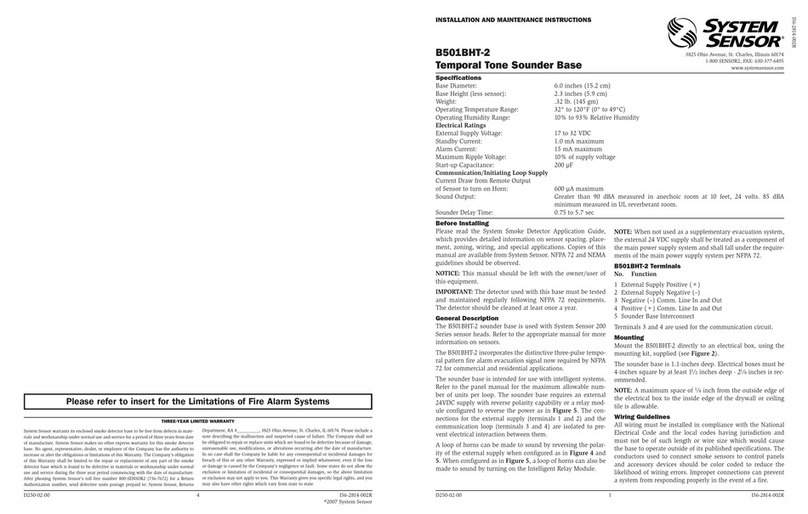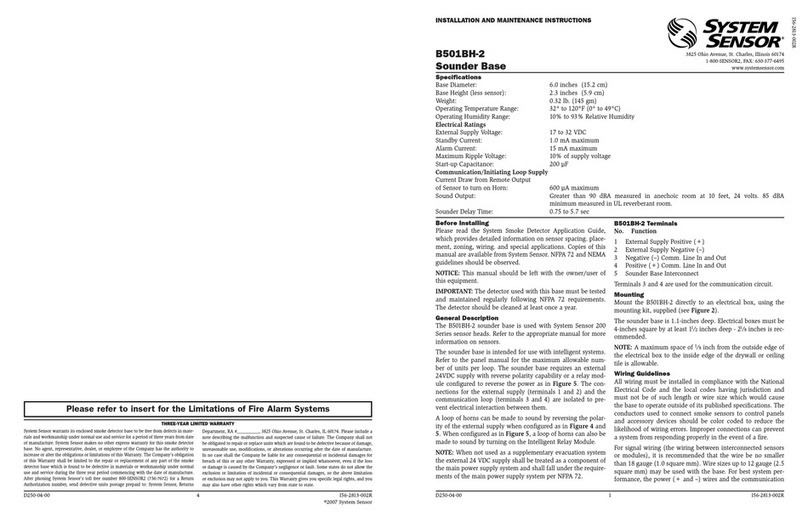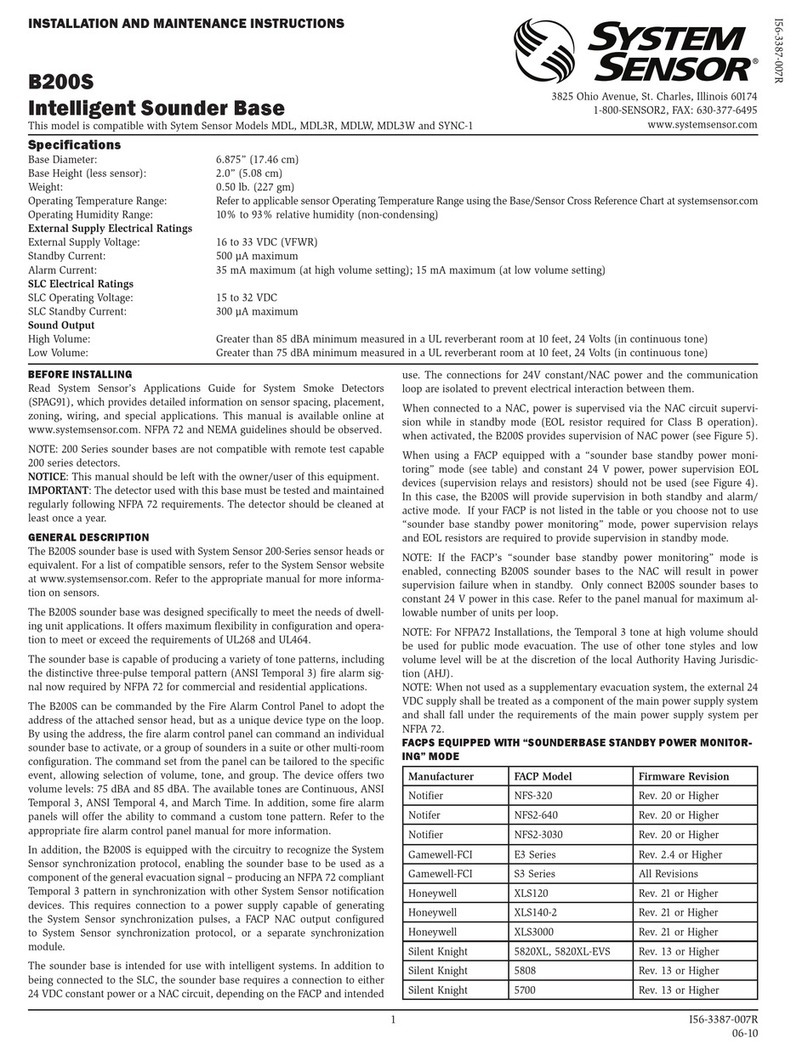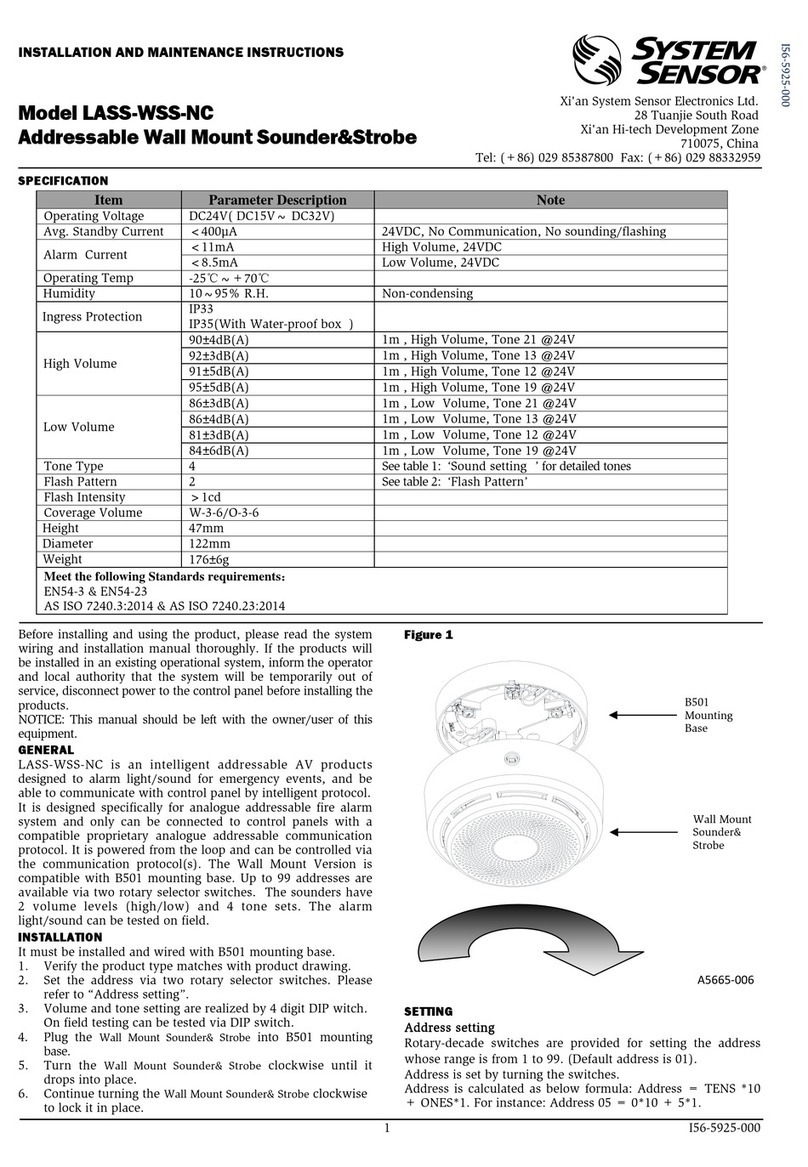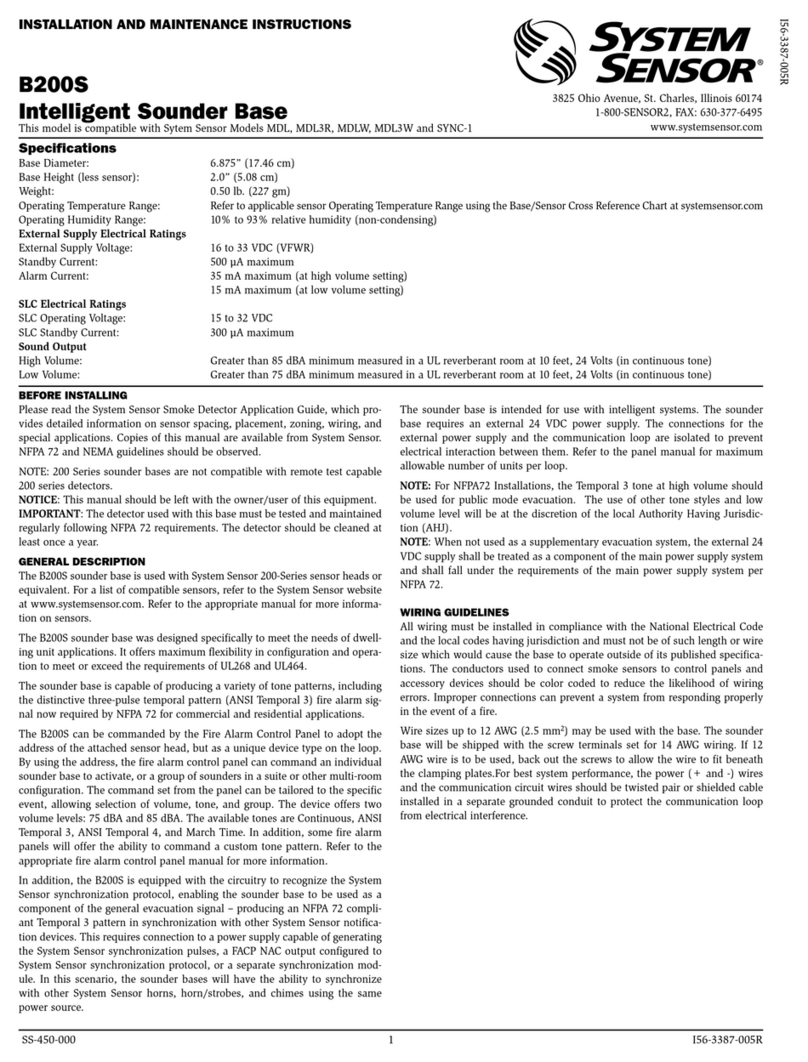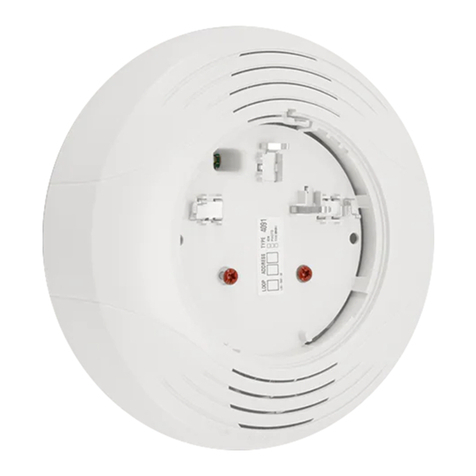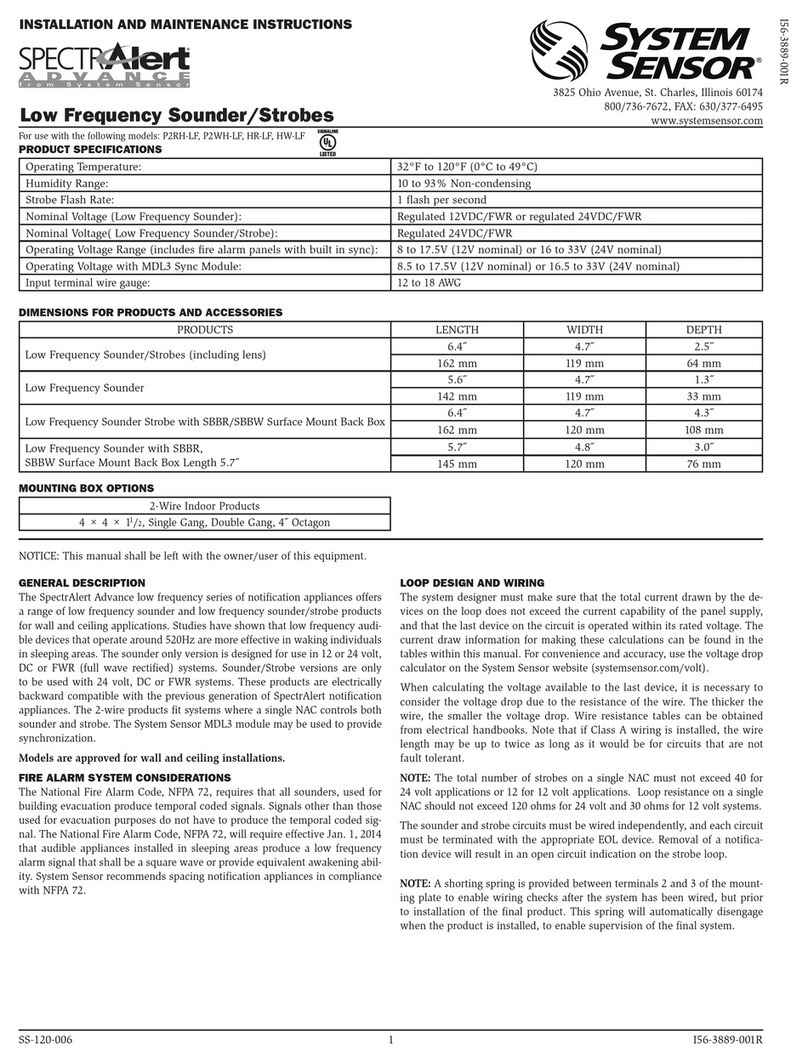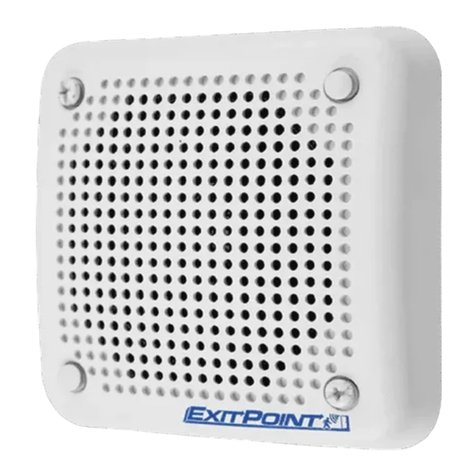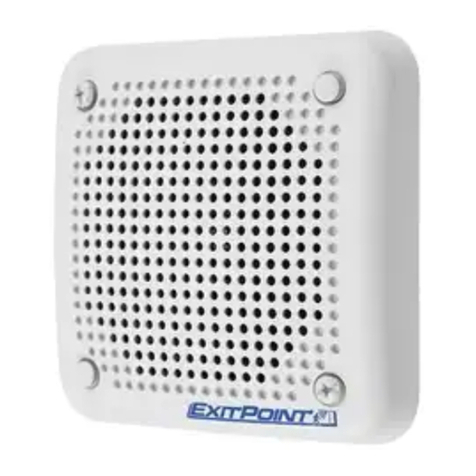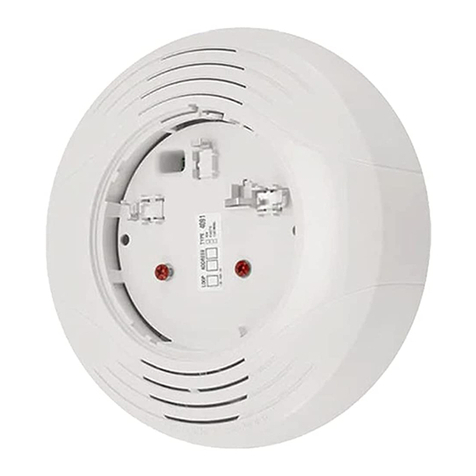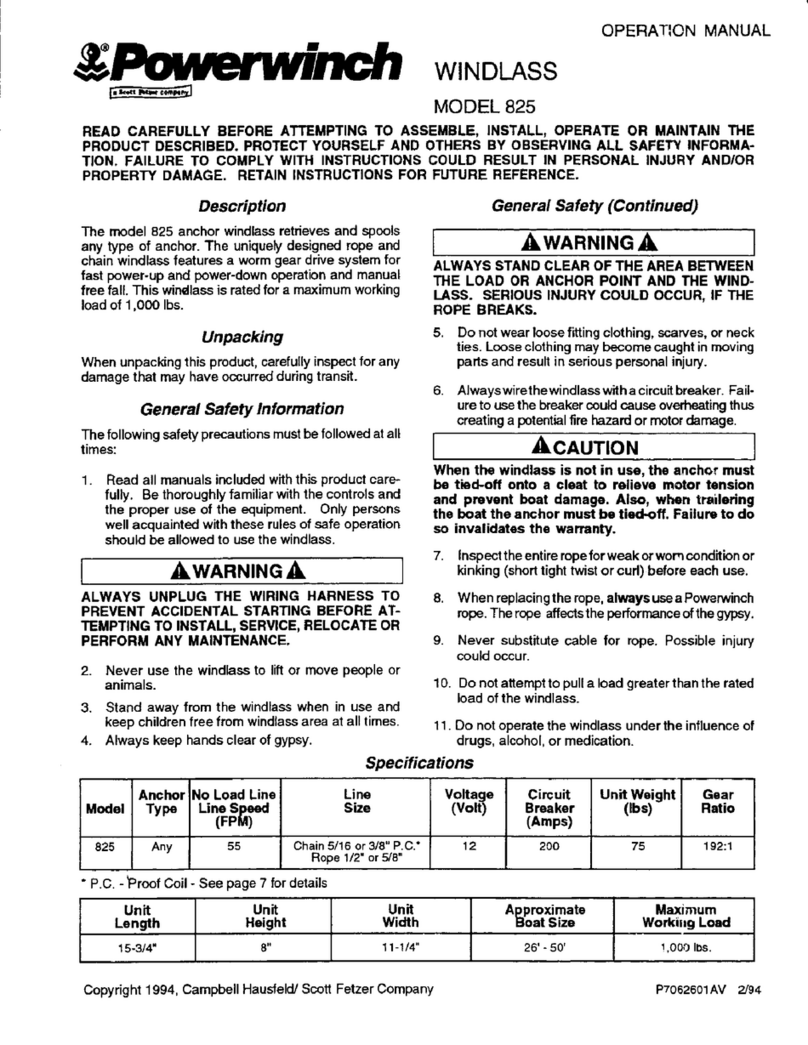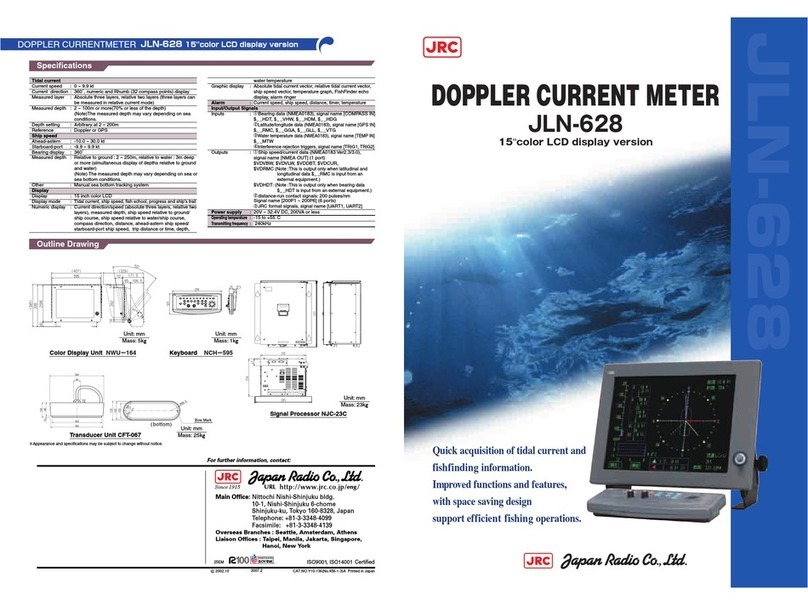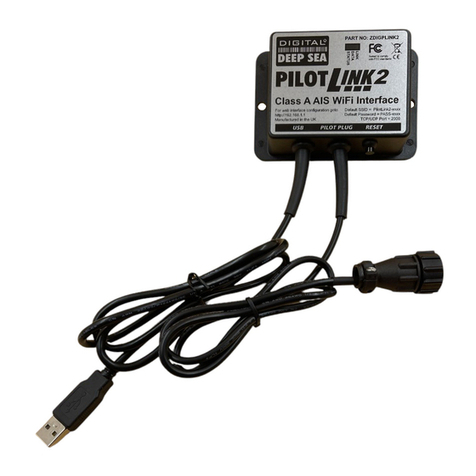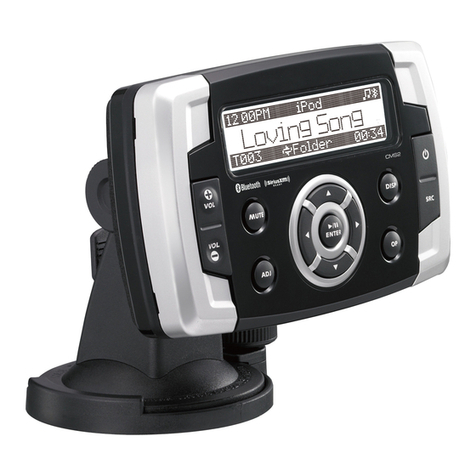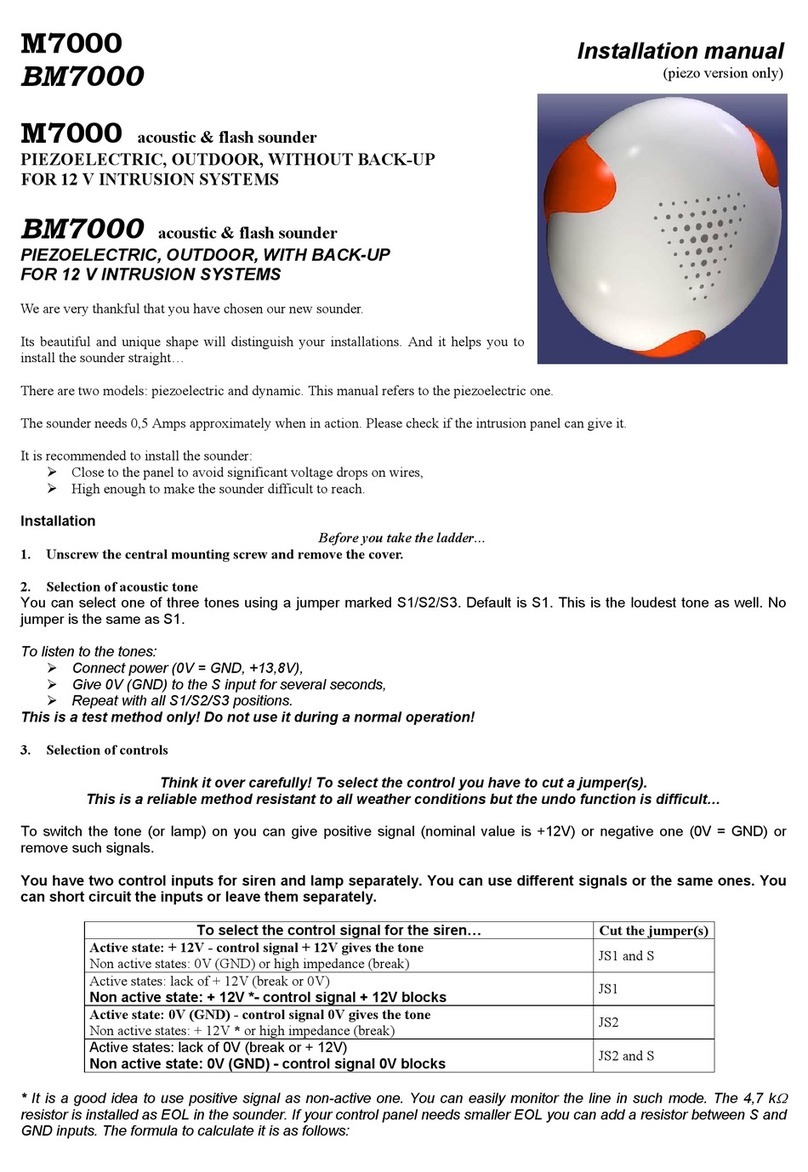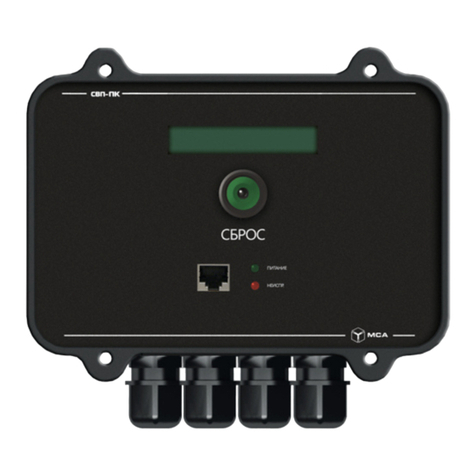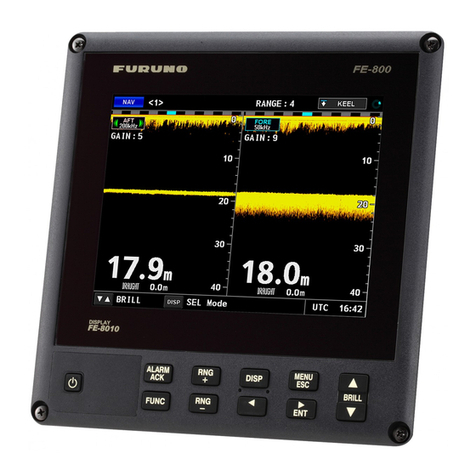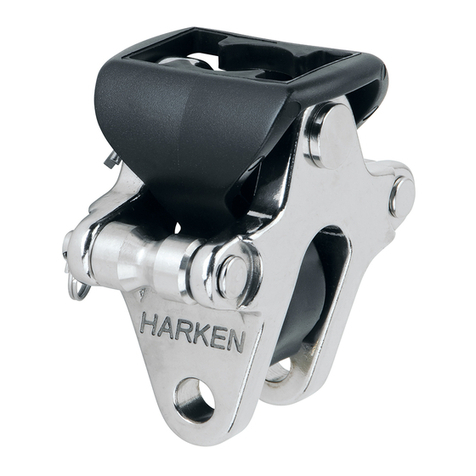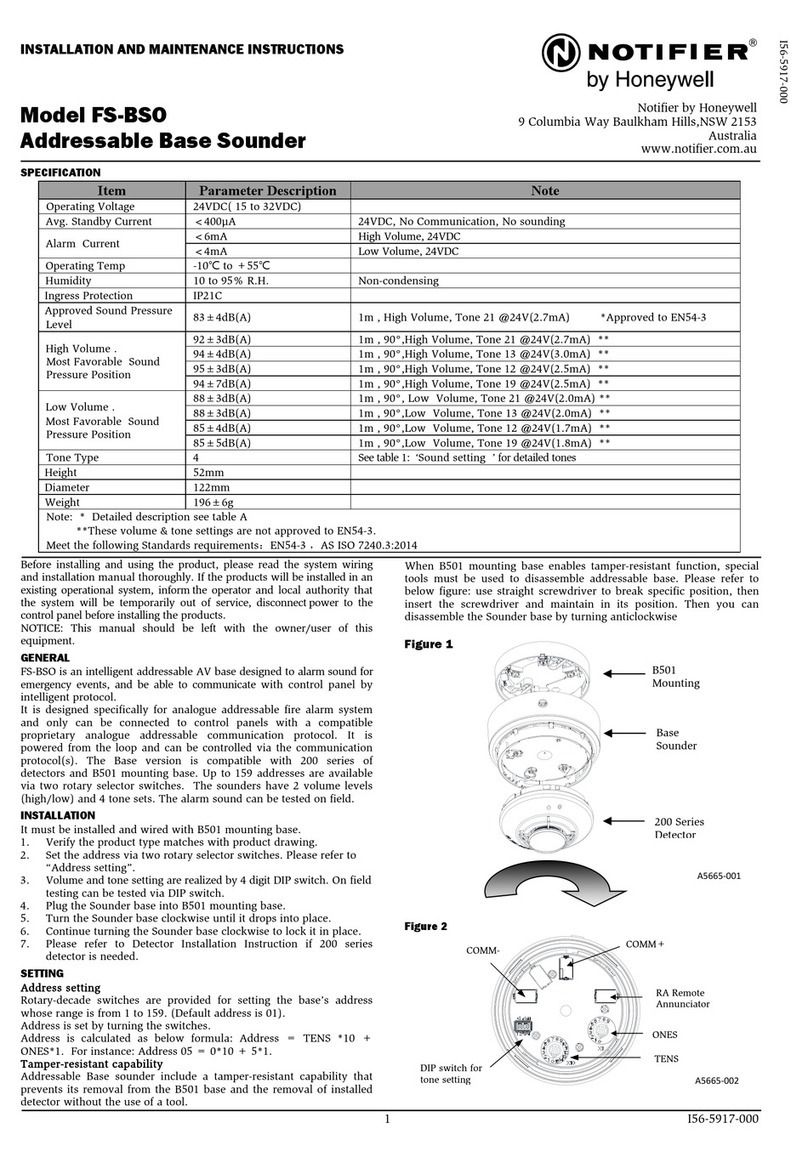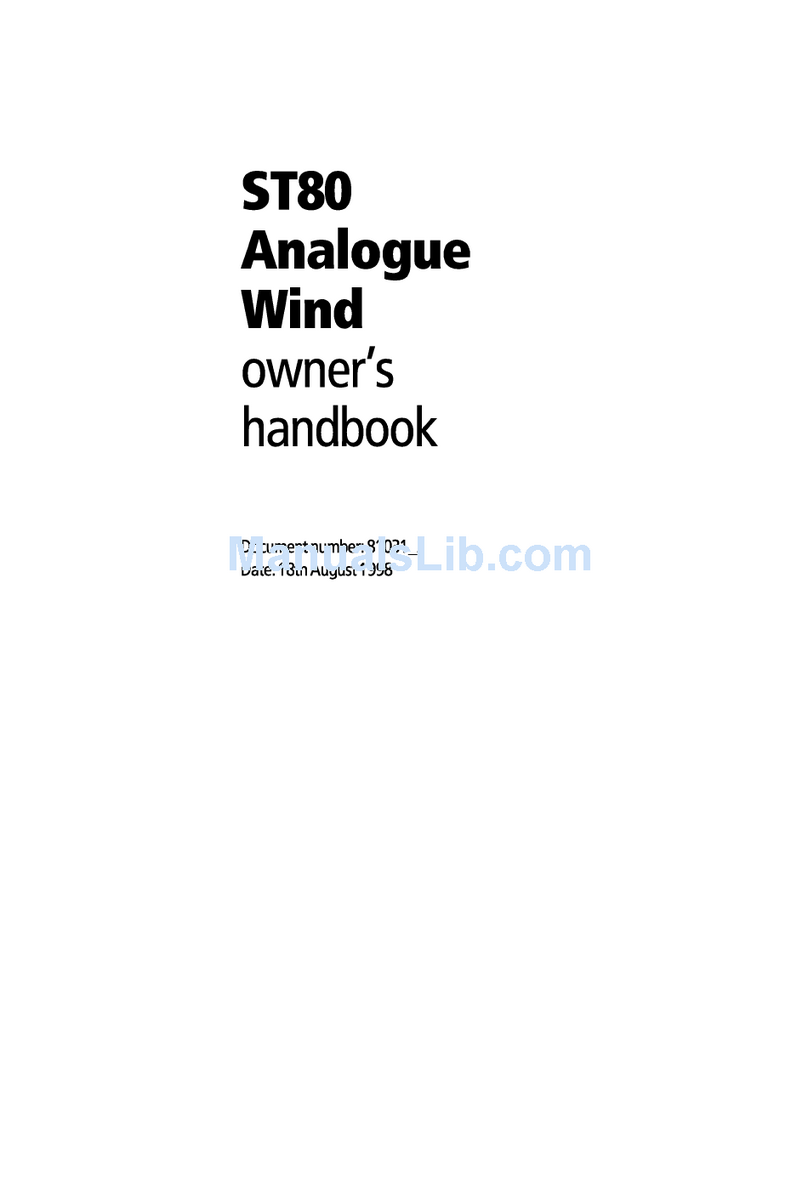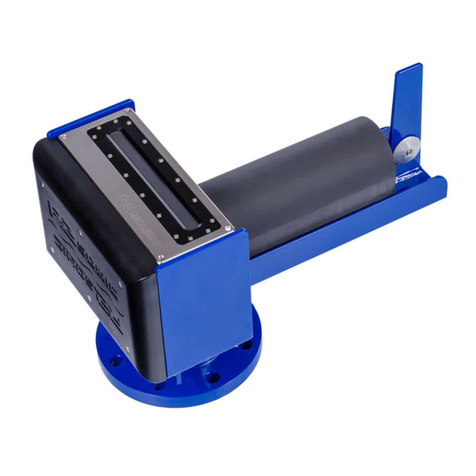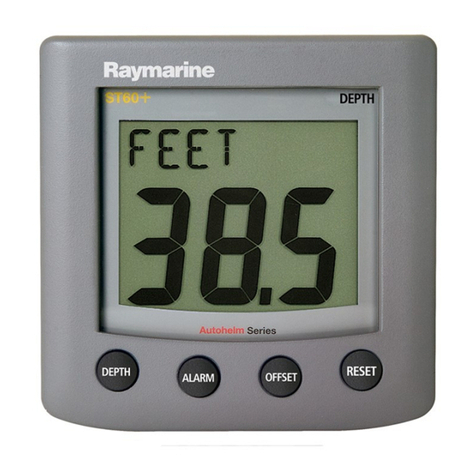
1 I56-6649-000
2/24/2020
GENERAL DESCRIPTION
The L-Series low frequency series of notification appliances offers a range
of low frequency sounder and low frequency sounder/strobe products for
wall and ceiling applications. Studies have shown that low frequency audible
devices that operate around 520Hz are more effective in waking individuals
in sleeping areas. These products are electrically backward compatible with
SpectrAlert Advance notification appliances. The 2-wire products fit systems
where a single NAC controls both sounder and strobe. The System Sensor
MDL3A module may be used to provide synchronization.
The models HGRLZA-LF and HGWLZA-LF include an LED alarm indicator
and silence switch. (See Figures 9 and 10.) During alarm, pressing the silence
switch will silence the horn and illuminate the LED for a maximum of 10 min-
utes. The silence can be reset by removing power for a minimum of 4 seconds.
Also included in these models is a silence test feature. To use this, activate the
NAC at the panel and put the system into alarm. Hold the silence button for
5 to 10 seconds and release; the unit will silence but resound in 10 seconds.
These devices are to be installed according to the requirements of the local
codes/authorities and CAN/ULC S524.
For non-silenceable models, install a separate remote switch with the sounder
or sounder strobes. Use a Residential Silence Module (model RSM-1A or a
RSM-1RA and RSM-1SWA) to comply with the requirements of the local
codes/authorities and CAN/ULC S524 for dwelling spaces.
Sounder-only models are approved for wall or ceiling installations.
Sounder Strobe models approved for wall use only.
FIRE ALARM SYSTEM CONSIDERATIONS
The National Building Code of Canada and CAN/ULC S525 require that all
sounders used for building evacuation produce temporal coded signals. Sig-
nals other than those used for evacuation purposes do not have to produce the
temporal coded signal. The National Fire Alarm Code, NFPA 72, requires that
audible appliances installed in sleeping areas produce a low frequency alarm
signal that shall be a square wave or provide equivalent awakening ability
(effective Jan. 1, 2014). System Sensor recommends spacing notification appli-
ances in compliance with NFPA 72.
LOOP DESIGN AND WIRING
The system designer must make sure that the total current drawn by the de-
vices on the loop does not exceed the current capability of the panel supply,
and that the last device on the circuit is operated within its rated voltage. The
current draw information for making these calculations can be found in the
tables within this manual. For convenience and accuracy, use the voltage drop
calculator on the System Sensor website.
When calculating the voltage available to the last device, it is necessary to
consider the voltage drop due to the resistance of the wire. The thicker the
wire, the smaller the voltage drop. Wire resistance tables can be obtained
from electrical handbooks. Note that if Class A wiring is installed, the wire
length may be up to twice as long as it would be for circuits that are not fault
tolerant.
INSTALLATION AND MAINTENANCE INSTRUCTIONS
L-Series
Low Frequency Sounder/Strobes
For use with the following models: Standard Wall Mount Sounder: HRLA-LF, HWLA-LF. Compact, Silenceable Wall Mount Sounder: HGRLZA-LF, HGWLZA-LF.
Ceiling Mount Sounder: HCRLA-LF, HCWLA-LF. Wall Mount Sounder Strobe: P2RLA-LF, P2WLA-LF.
(Sounder Strobes have English/French marking. Bezels required for other languages are sold separately.)
PRODUCT SPECIFICATIONS
Operating Temperature: 32°F to 120°F (0°C to 49°C)
Humidity Range: 10 to 93% Non-condensing
Strobe Flash Rate: 1 flash per second
Nominal Voltage (Low Frequency Sounder): Regulated 24VDC/FWR
Nominal Voltage( Low Frequency Sounder/Strobe): Regulated 24VDC/FWR
Operating Voltage Range (includes fire alarm panels with built in sync): 16 to 33V (24V nominal)
Operating Voltage with MDL3A Sync Module: 16.5 to 33V (24V nominal)
Input terminal wire gauge: 12 to 18 AWG
Silence Time 10 minutes max.
Power down time to reset silence 4 seconds
DIMENSIONS FOR PRODUCTS AND ACCESSORIES
WALL PRODUCTS Length Width Depth
Standard Sounder
5.6" (143mm) 4.7" (119mm) 1.5” (38 mm)
Sounder Strobe
5.6” (143mm) 4.7” (119mm) 1.93” (49mm)
Compact Silenceable Sounder
5.26" (133 mm) 3.46" (88 mm) 1.5” (38 mm)
Standard device with SBBRL/WL Surface Mount Back Box 5.7" (145 mm) 4.8”(120mm) 3.3” (84mm)
C
ompact device with
SBBGRL/WL Surface Mount Back Box
5.4" (137 mm) 3.6”(91mm) 3” (76mm)
NOTE: SBBRL/WL Surface Mount Back Box intended only for standard sounder and sounder strobe. SBBGRL/WL
Surface Mount Back Box intended for compact sounder.
CEILING PRODUCTS Diameter Depth
Sounder
6.83" (173.5mm) 1.4” (36mm)
Sounder with SBBCRL/WL Surface Mount Back Box 6.92" (175.8mm) 3.9” (99mm)
JUNCTION BOX OPTIONS
Standard Indoor Products: 4" x 4" x 1½" (10.16 cm x 10.16 cm x 3.8 cm), Single Gang, Double Gang, 4" Octagon, SBBRL/WL (wall), SBBCRL/WL (ceiling)
Compact Indoor Products: Single Gang, SBBGRL/WL (wall)
NOTICE: This manual shall be left with the owner/user of this equipment.
I56-6649-000
3333 Unity Drive, Mississauga, ON L5L 3S6
800/736-7672, FAX: 905-812-0771
www.systemsensor.ca
